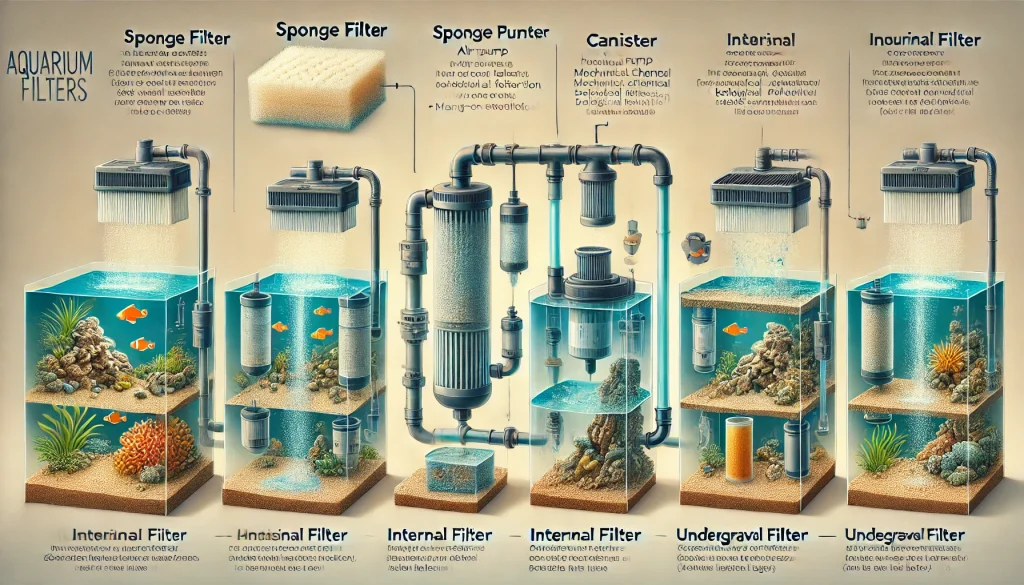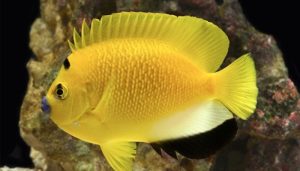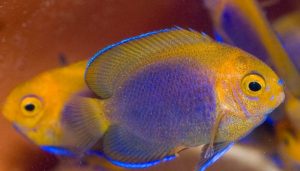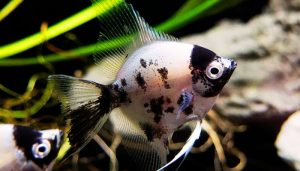Can betta fish be in a filtered tank? Betta fish are undeniably one of the most popular and captivating freshwater species, known for their vivid colors and flowing fins. But to truly see them thrive, creating the right environment is crucial. While many first-time owners might consider small bowls or stagnant setups, a Betta Fish in Filtered Tank offers unmatched benefits for their health and well-being.
The gentle movement of water in a filtered tank not only helps maintain pristine water quality but also mimics their natural habitat, reducing stress and enhancing their vibrant appearance.
In this post, we’ll dive into the essentials of setting up the perfect filtered tank for your betta.

From selecting the right tank size and filter type to understanding aquarium water parameters and décor, you’ll learn how to craft an environment that supports their unique needs.
Whether you’re a beginner or an experienced aquarist, this guide will highlight why a filtered tank isn’t just a luxury for bettas—it’s a game-changer for their health and happiness. Ready to transform your betta’s home into a sanctuary that lets them shine?
Keep reading to discover everything you need to know about setting up and maintaining the ideal environment for your aquatic companion.
Table of Contents
ToggleCan Bettas Live in Filtered Fish Tanks?
Yes, betta fish can live in filtered fish tanks. In fact, a filter is often recommended for betta tanks, especially those larger than 5 gallons.
Here’s why:
- Water Quality: Filters help maintain good water quality by removing harmful ammonia and nitrites, which are waste products from the fish. This is crucial for the betta’s health.
- Oxygenation: Filters introduce oxygen into the water, which is essential for the betta to breathe.
- Stability: Filters help keep the aquarium water temperature and pH stable, creating a more consistent environment for your betta.
However, it’s important to choose the right aquarium filter for betta fish. Some filters create strong currents, which can stress out bettas. Look for a filter with adjustable flow or consider adding a sponge filter to reduce the current.
When considering a gallon tank with a filter, it’s essential to choose a different filter that is gentle enough for your fish. A 3 gallon or even a 2.5 gallon tank can accommodate a single betta effectively, as long as the filter does not create strong currents.
If you’re transitioning from a tank without a filter, you will need to put the fish in a new environment with new water, so it’s crucial to acclimate the betta slowly. You should also have a water test kit to monitor the parameters.
Beneficial bacteria in the filter will help maintain a healthy environment, but remember, the filter material may need to be replaced periodically. If you’ve got our first betta fish and are considering a betta fish forum, you’ll discover plenty of advice on keeping your fish happy.
Why Keeping Betta Fish in Filtered Tank Matters?
Setting up a filtered tank for betta fish can greatly enhance their living conditions, ensuring they thrive in a healthy environment.
Understanding the specific needs of betta fish, including their habitat preferences and water quality, is essential for any aquarist. This article will explore the best setup for betta fish in tank with filter, discussing the importance of filtration, types of filters available, and the benefits of keeping a clean aquarium.
Betta Fish Habitats With Filtered Tanks
Betta fish thrive in well-maintained habitats, which can be effectively achieved through a filtered tank. These tropical fish prefer warm water temperatures, typically between 76°F and 82°F, and a tank that mimics their natural environment.
A filtered tank helps maintain stable water parameters, necessary for their health. The use of a heater is advisable in conjunction with a filter to keep the water temperature consistent.
Additionally, incorporating live plants can enhance the tank’s aesthetics while providing hiding spots and improving water quality.
Creating a suitable habitat for your betta fish involves selecting the right tank size, ideally a minimum of 5 gallons, to ensure ample swimming space. A tank with a filter can help maintain optimal water quality by reducing toxins and waste buildup.
Bettas prefer calm waters, so it is vital to choose a filter that doesn’t create excessive water flow. A sponge filter can be an excellent choice as it provides gentle filtration and aeration. Thus, a well-equipped filtered tank contributes significantly to the well-being of your betta fish.
New Betta Fish likes to be Sucked by Filter, but it’s essential to understand why this behavior occurs and how to ensure the well-being of your fish.
Bettas are curious creatures, often exploring their environment. The gentle flow of water from a filter can attract them, giving them a sense of stimulation and movement.
However, relying solely on the filter’s suction can be harmful. Bettas have long, flowing fins that can easily get caught or damaged in strong currents.
Do Bettas Need A Filter?
While betta fish can survive in smaller, unfiltered tanks or fish bowls, they significantly benefit from having a filter. Bettas thrive in clean water, and using a filter helps maintain water quality by removing debris and harmful substances.
A filter also promotes beneficial bacteria that aid in breaking down waste, which is crucial for the overall health of your aquarium.
Therefore, utilizing a filter not only enhances the living conditions for bettas but also reduces the frequency of water changes required by the aquarist.
In a tank with a filter, betta fish experience less stress compared to those kept in unfiltered environments. This is because filtered tanks maintain stable water conditions, which are vital for the fish’s well-being.
Regular water testing can help monitor the tank’s parameters, ensuring they remain within acceptable ranges. Consequently, while a betta can survive without a filter, it is evident that they thrive better when housed in a filtered tank, emphasizing the importance of filtration in their care.
Examples of Aquarium Filters:
There are various types of aquarium filters available, each offering unique benefits for your betta fish setup. The most common types include power filters, sponge filters, and internal filters.
Power filters are efficient and suitable for larger tanks, providing excellent water flow and filtration.
In contrast, sponge filters are gentle and ideal for smaller tanks, ensuring that the water flow does not disturb your betta fish. Internal filters, which are submerged within the tank, also offer effective filtration while being less obtrusive.
When selecting the best filter for a betta tank, consider factors such as tank size, flow rate, and noise level. A 10-gallon tank may benefit from a power filter, while a 3-gallon tank would be better served by a sponge filter.
It’s crucial to choose a filter that effectively cleans the water without creating turbulence, as bettas prefer calm waters. Therefore, knowing the different types of filters can help you make informed decisions when setting up your betta fish aquarium.
Diagrams of the Different Types of Filter
There are several common types of aquarium filters, each with its unique design and function. Below is a description of the main types along with a general idea for diagrams:
1. Hang-On-Back (HOB) Filters
- Description: These are external filters that hang on the back of the aquarium. Water is drawn up through an intake tube, passes through the filter media, and is returned to the tank.
- Diagram Features:
- Intake tube extending into the tank.
- Filter box hanging on the tank edge.
- Water flow arrows showing suction, filtration, and output.
2. Canister Filters
- Description: External units placed below the aquarium. Water is siphoned out of the tank, passed through various layers of filter media, and pumped back into the tank.
- Diagram Features:
- Tank with two hoses (one intake, one output).
- Canister unit showing internal media layers (mechanical, chemical, biological).
- Arrows illustrating water flow.
3. Sponge Filters
- Description: Air-driven filters that provide mechanical and biological filtration. Best for small tanks or breeding setups.
- Diagram Features:
- Sponge sitting inside the tank.
- Air pump connected via tubing to an uplift tube.
- Bubbles and water flow circulating through the sponge.
4. Internal Filters
- Description: Submersible filters placed inside the tank. They include a pump that draws water through the filter media.
- Diagram Features:
- Filter unit submerged in the tank.
- Suction cups holding the filter against the tank wall.
- Arrows showing water intake and output.
5. Undergravel Filters
- Description: A perforated plate placed under the gravel substrate. Water is drawn through the gravel by a pump or air-driven uplift tube, providing biological filtration.
- Diagram Features:
- Tank bottom with gravel substrate.
- Perforated plate beneath the gravel.
- Uplift tube connected to an air pump or powerhead.
- Arrows showing water flow through gravel.
6. Sump Filters
- Description: Large external filtration systems housed in a separate tank below the main aquarium. They offer mechanical, chemical, and biological filtration.
- Diagram Features:
- Main tank with an overflow system.
- Sump tank with sections for filter media, refugium, and return pump.
- Water flow arrows from the main tank to the sump and back.
7. Fluidized Bed Filters
- Description: Filters that use suspended sand or other media in a column of flowing water for biological filtration.
- Diagram Features:
- Vertical tube or column.
- Sand particles suspended in the flow.
- Water input and output arrows.
Here is the detailed diagram illustrating the various types of aquarium filters, including their components and functionality.

Can I Do Weekly Water Changes instead of Using a Filter?
While performing weekly water changes can help maintain water quality, it is not a substitute for using a filter. Regular water changes are essential for keeping the tank clean and removing accumulated waste and toxins.
However, filters play a crucial role in breaking down waste biologically, providing a more stable environment for your betta fish.
A combination of both methods is ideal; using a filter will help keep the water clean between water changes, reducing the overall workload for the aquarist.
In a filtered tank, the need for frequent full water changes can be minimized. Instead, partial water changes become more effective, allowing beneficial bacteria to thrive and helping to maintain a balanced ecosystem within the aquarium.
While some aquarists may consider solely relying on water changes, it’s important to remember that filters contribute significantly to the overall health of the tank. Therefore, integrating both filtration and regular aquarium water changes will provide the best care for your betta fish.
Is Waste Broken Down Naturally without a Filter?
Without a filter, waste in a betta fish tank may break down naturally, but this process can be slow and inefficient. Beneficial bacteria play a critical role in breaking down waste, and while they can exist in unfiltered tanks, their effectiveness is often compromised.
In a filtered tank, these bacteria thrive in the filter media, providing continuous biological filtration that keeps harmful substances at bay. Therefore, while some waste may break down naturally, a filter greatly enhances this process, ensuring a healthier environment for your Siamese fighting fish.
In unfiltered tanks, waste accumulation can lead to poor water quality, resulting in stress and health issues for bettas. Regular water changes may be necessary to manage waste levels, but this approach requires more frequent maintenance.
In contrast, a filtered tank allows for a more stable environment, with beneficial bacteria efficiently breaking down waste.
Thus, while some natural breakdown occurs without a filter, utilizing one significantly improves the overall health and stability of the aquarium, highlighting the importance of filtration in keeping betta fish.
Commonly Asked Questions about Keeping Betta Fish in Tank with Filter (FAQs)
Can betta fish live in a filtered tank?
Can betta fish live in filtered tank? However, strong filters can create excessive water flow, stressing bettas. Use a sponge filter or adjust a power filter to create gentle current.
What size tank do betta fish need?
Betta fish need a minimum of a 5-gallon tank, but a 10 gallon tank is recommended for optimal health and space.
Do I need a filter for my betta fish tank?
Yes, betta fish need a filter in their tank to maintain water quality and provide a stable environment, but the filter should be gentle to avoid stressing the fish.
What is the best filter for a betta fish?
The best filter for a betta is one that has adjustable flow settings or a sponge filter, as this will provide filtration without creating strong currents that can distress the fish.
How often should I change the water in my betta fish tank?
You should change about 25-50% of the tank water weekly to keep it clean, especially in a new tank where water quality can fluctuate.
Can I keep more than one betta in the same tank?
No, it’s not recommended to keep multiple bettas in the same tank unless it’s a breeding setup, as they are territorial and will fight, leading to stress or injury.
What kind of water conditioner should I use for my betta fish?
You’ll need a good water conditioner that removes chlorine, chloramine, and heavy metals from tap water before adding it to your betta’s tank.
How do I properly set up a new tank for my betta fish?
To set up a new tank for your betta fish, start with a clean tank, add substrate, set up your filter, fill the tank with dechlorinated water, and let it cycle for a few days before introducing the fish.
What should I do if I got a new betta fish?
If you got a new betta fish, acclimate it slowly to the tank water by floating the sealed bag in the tank for about 15-20 minutes, then gradually mix some tank water into the bag before releasing the fish.
Is a 2.5-gallon tank suitable for a betta fish?
A 2.5-gallon tank can be used for a betta fish, but it is not ideal. A larger tank, such as a 5-gallon or 10-gallon tank, is better for providing a more stable environment.
Conclusion
Setting up a filtered tank for betta fish is essential for their health and well-being. A filter not only helps maintain water quality but also reduces the need for frequent water changes. By understanding the specific needs of betta fish, including preferred habitats and aquarium water conditions, aquarists can create an ideal environment for their pets. Utilizing the right type of filter, whether it be a sponge filter or a power filter, ensures that the tank remains clean and stable.
Ultimately, keeping a Betta fish in filtered tank requires a commitment to maintaining their habitat, and a filtered tank simplifies this process. With the right setup, including a heater and possibly live plants, your betta fish will thrive in a comfortable and clean environment. In conclusion, investing in a filtered tank setup is undoubtedly the best approach for anyone looking to provide optimal care for their betta fish.
You might also like
- How Often to Change Betta Tank Water Without Filter: (5 Pro Tips)
- How to Care of Betta Fish without a Tank Filter: (Solved)
- How Big of a Fish Tank Does a Betta Needs: (Exclusive Guide)
- How to Know If My Betta Fish Is Dying: (5 Warning Signs)
- Betta Fish Not Eating and Laying at the Bottom: 3 Reasons Solved
- Can Betta Fish Live in a Small tank or Bowl Without Filter? (Solved)
- Can Betta Fish Have a Filter in Their Tank: (Exclusive Guide)
- How Often Will Bettas Breed: 5 Simple Tips to Boost Fertility




